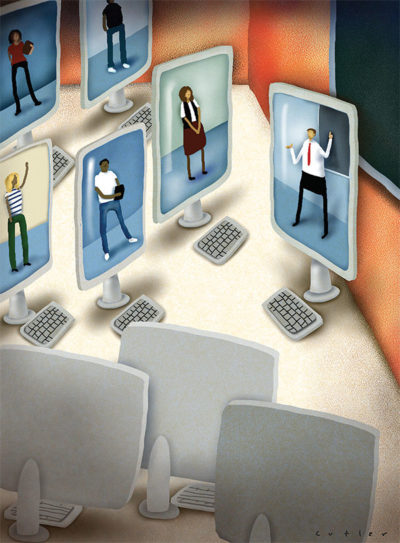In April 2016, Babson joined edX, a provider of massive open online courses, or MOOCs, agreeing to create 15 courses over three years. “Online environments play an increasingly important role in businesses,” says Sal Parise, professor of information systems. Parise also serves as the faculty director of BabsonX, the partnership between Babson and edX. “Every company today has to have a digital strategy, regardless of what product they sell.” Higher education, he says, is no exception.
When MOOCs burst onto the scene almost 10 years ago, they were greeted as higher education’s savior—or its downfall. The free online classes held out the promise of bringing college within reach of anyone with internet access. But some observers feared that access could undermine the traditional college model. Nonetheless, many colleges and universities got on board. Both the dire predictions and the overblown promises have yet to be realized, but one thing remains clear, says Parise: “MOOCs are not going away.”

Illustration: Dave Cutler/theispot.com
EdX began as a collaboration between MIT and Harvard and is now a leading provider of online courses, with more than 70 schools on board. Babson joined edX because it offered the support and reach the College sought in the MOOC marketplace. The first six courses that Babson is offering—a basic business suite covering such topics as financial analysis, marketing fundamentals, and the entrepreneurial mindset—were launched in January.
Translating Babson’s content into online courses proved to be no easy matter—even for those who have created digital content for the College’s blended learning programs. “I thought it would be a simple migration,” says Mark Potter, professor of finance. “And that was wrong.” One big difference, he says, is the sheer size of the classes: 50 or so in a blended learning MBA class, compared with perhaps 5,000 in a BabsonX class. BabsonX classes are designed to run both “live,” in real time, and “self-paced.” But even in live classes, it simply isn’t possible to interact with every student. So professors connect with students beyond the “classroom” through discussion boards, which Potter says he enjoyed, spending a couple of hours a day on the boards during the four weeks of his live class.
The static nature of online material also proved a challenge. “During a typical class, I like reading students’ reactions and adapting on the fly,” Potter says, “and all of a sudden, I’m talking to a camera.” But Potter says the academic technologies team, headed by Eric Palson, has done an exemplary job of designing and creating content in partnership with faculty members. It’s not just a matter of pointing a camera at a professor and letting him or her talk, says Palson. “That can get very boring, very fast,” he says. His team works with faculty to create graphics, animated segments, and more to ensure the courses are visually compelling as well as intellectually engaging.
Creating the online courses represents an investment of time, money, and resources. But supporters of the effort cite a slew of potential benefits for the College, from raising awareness about Babson to increasing enrollment to connecting with alumni to providing prerequisites for admitted grad students to sharing the College’s mission. Although the program is still in its early stages, by those measures it’s already a success. Says Potter: “We can reach so many people who wouldn’t ordinarily get touched by Babson’s curriculum and staff. The investment was a pretty small price to pay.”—Jane Dornbusch
